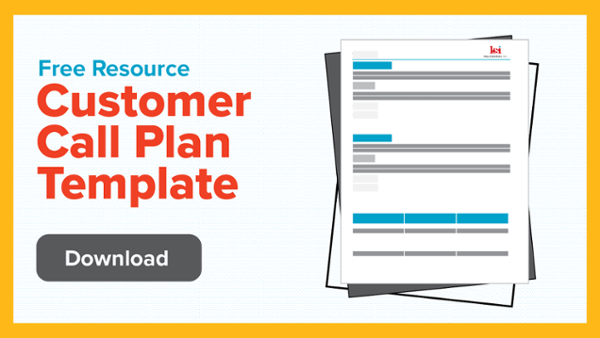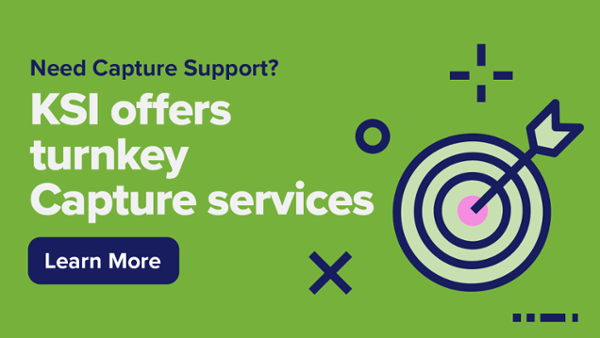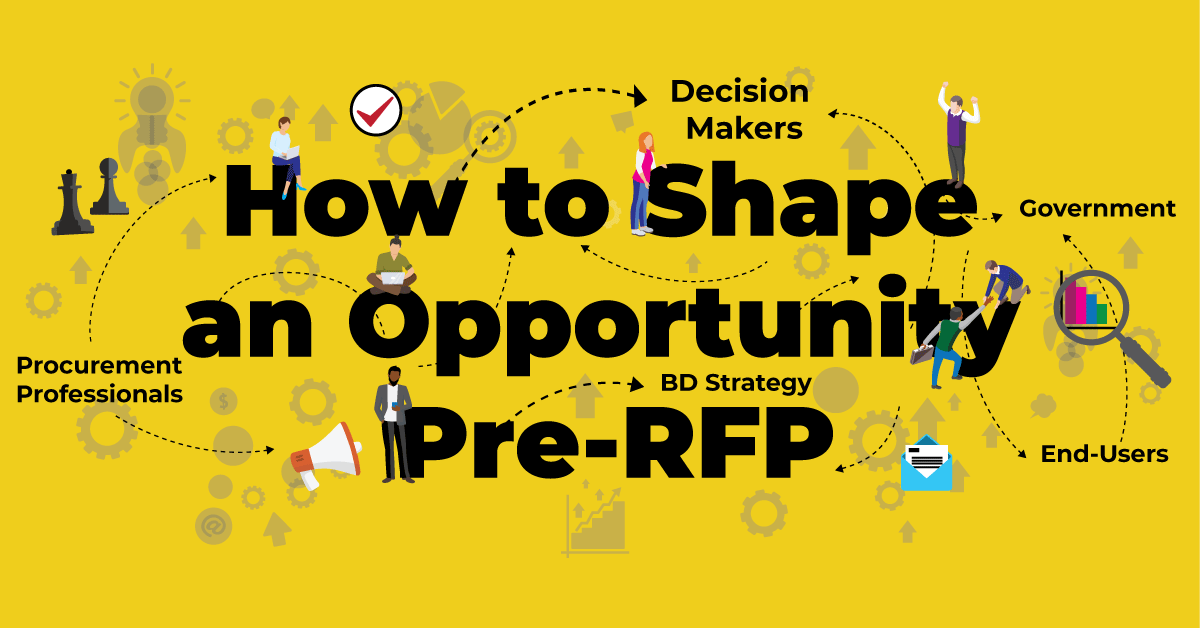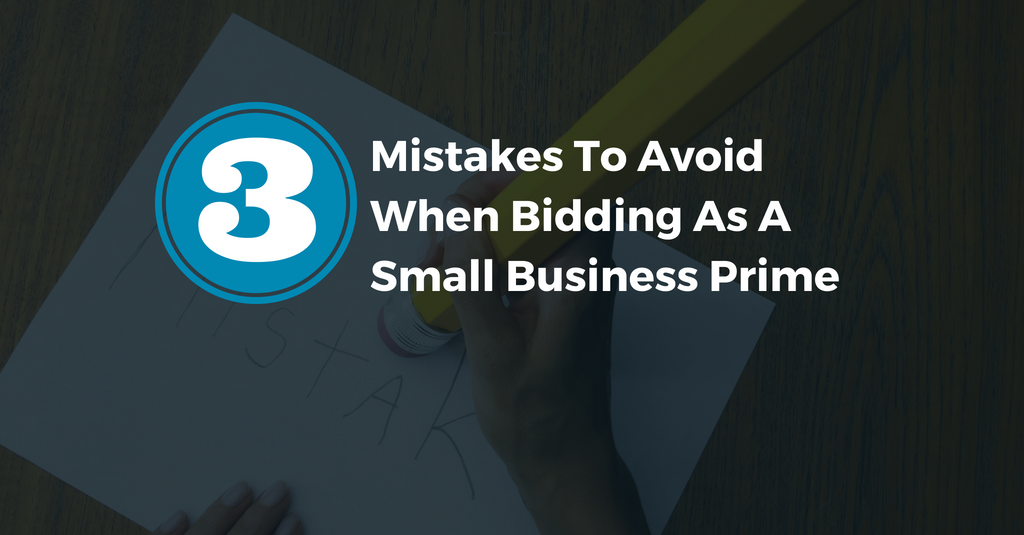Learning how to make smart bid/no-bid decisions is one of the most crucial skills individuals and government contractors can develop to improve their overall success.
Smart bidding is as much about when to say yes as it is about when to say no: knowing your positioning for an opportunity, being able to make adjustments to improve win probability, and objectively assessing and re-assessing your positioning is key for making confident bid decisions that will result in better outcomes.
The proposal development process draws heavily on a company’s resources, so it is best to focus on opportunities that you have a good chance of winning.
Constantly chasing multiple opportunities with the hope of winning a few is an imprecise and expensive approach that does more harm than good. Find yourself stuck in a cycle of chasing too many opportunities and not getting the wins you were expecting?
In this post we dive into how to break the cycle and approach your bids with precision to increase your win rate while reducing stress in your team and improving your profitability.
“No” is your new default.
Nobody gets into business development because they don’t want to pursue bids. This basic truth makes no-bidding a complicated, sometimes fraught choice but too many bid/no-bid meetings and gate reviews begin with the typical “why not go after it?”

Instead, justify to yourselves and senior management why you should go after an opportunity. This justification should be based on data and facts, and should be grounded in an honest inventory of your capabilities, positioning, and preparation, as well as the customer’s hot buttons and perceptions, competitive landscape, and greater trends relative to the bid.
A few years ago, to commemorate the purchase of my new car, I decided to get my first set of vanity plates. I went to the DMV website and started searching for what options were available, and tried my favorite option: NO BID. It was available, and I was thrilled at the thought of proselytizing my message to business development and proposal professionals. I presented my idea to my coworkers, and wasn’t entirely surprised at the moderate outrage that I received in response.
Do not spend B&P dollars on efforts you know you cannot win; instead, use the funds to position the company for more viable opportunities that will drive revenue.
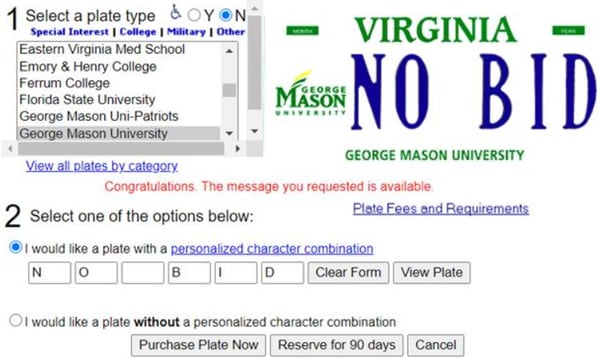
Each proposal is a choice; making careful choices helps preserve your proposal team and make smart investments.
Treat proposals as an expenditure you choose to make, not a default action.
Track how many proposals your staff is working on at a given time and recognize when people are overworked.
Be proactive in determining when it is time to bring in external help to provide targeted proposal support and increase your chances of winning.
Make informed decisions.
Can you deliver the work at the price point you’re bidding? Winning an award is only half the battle. You will face operational and reputational challenges if you win an award you are ill-equipped to deliver on. You could lose money, face legal action, and damage the perception of your company permanently.
So how do I make a bid/no-bid decision?
Start with a team that can conduct a rigorous bid/no bid process. Be honest and objective about your capabilities and chances of winning. Clearly communicate the following data points to your stakeholders to assist in their decision-making:
- Does this opportunity align with our core business?
- Is there an incumbent?
- How much do we know about the background of this opportunity and the customer’s hot buttons?
- What is our relationship with the client?
- Do we have a talented team and internal resources to put together a credible bid?
- Do we have the technical capability, past performance, and staffing the effort requires?
- Do we have the financial resources for the cost of pursuit and the range of investments the project will require?
- What is the expected profit margin and return on investment?
- What are the opportunity costs of deployed assets?
- What are the potential risks and liabilities we are undertaking in pursuing this contract?
- What are the competitive considerations?
- What is the probability of us winning the contract?
- How will an award of contract fit in our overall business plan and strategy?
- Will winning the award move the company forward in the right direction?
- Will we grow in the field or areas we would like to position the company in?
If you do not have a positive response to any of these questions, it may be wise to no-bid. If responses that were initially positive change while you are developing the proposal, you should re-evaluate your stance. It can be helpful to use a tool for calculating a numerical representation of the strength of your bid. This allows bids to be compared methodically and is used to represent a collective measure of the numerous variables that go into bid decisions.
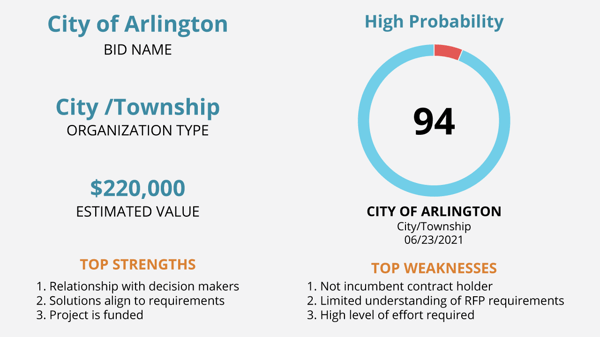 Screenshot is taken from the Patri Bid Score™ Tool
Screenshot is taken from the Patri Bid Score™ Tool
Using Win Probability (Pwin) Projections the right way.
Pwin is one common measure that you may hear discussed in bid decision meetings.
There is little standardization across companies in how exactly pwin is calculated, which means that this measure isn’t always useful, depending on how it has been generated. Pwin should be based on a codified formula grounded in actual data and customer intel, rather than an individual’s feelings of confidence. The prior bullet points we listed above, should be part of your pwin calculation — without a concrete set of assessment criteria, a pwin calculation is not a truly objective, translatable figure.
One method Key Solutions uses for our clients is Patri, now OpenGTM, an innovative SaaS tool powering data-driven bid decisions and increasing win rates. We combine our KSI Advantage™ capture process with OpenGTM's intelligence tool, allowing us to customize your assessment questions and scoring to tailor your company’s unique strengths, weaknesses, and qualification criteria.
By incorporating a set of assessment criteria, you have a standard, data-driven construct for objectively viewing the strength of your bid, as seen in the above screenshot. This allows you to focus on the opportunities with the highest probability of driving revenue.
Move toward a position of “No Pop Ups” and “No Surprises.”
An opportunity that suddenly pops up is usually a symptom of a greater problem in your Business Development pipeline and forecasting. It may represent a lack of understanding of the client or poor information sources.
It’s not to say you categorically cannot pursue any of these opportunities, but it is generally an indication that you are starting late in the game or have poor intel. No matter how limited your timeline, pop-ups still need to undergo the bid/no-bid process.
Determining which bids you are positioned to win and knowing when to walk away can enable you to maximize your resources and meet your company’s goals through a targeted approach.
Here are four primary reasons to walk away from a bid:
1. The opportunity does not fit into your business plan or corporate strategy
First, establish a clear strategy at the corporate level for the types of work to engage in. Which agencies, customers, industries, technical fields, and services fit in your overall business plan?
One way to uncover this information is through a Market Assessment. This analysis will provide you with a full competitive scope and actionable intelligence, ensuring your team is positioning your strongest capabilities, spending time with the right customers, and pursuing the right opportunities. A controlled scope will give you clarity to direct a coordinated and focused effort toward your goals. Your business plan should direct the bids you pursue and guide you to invest in the right resources such as technology, infrastructure, and personnel.
Communicate the corporate strategy to your team so everyone understands why you may or may not pursue an opportunity. Having a shared sense of purpose promotes consistent messaging and keeps morale high. The last thing you want in the middle of a stressful proposal is people asking: “why are we doing this?”
Compare potential bids to your strategy during your bid/no-bid decisions. If the objectives of the proposed contract do not fit in your business plan or overall strategic vision, walk away. Additionally, make sure that winning one award will not preclude you from pursuing contracts that may better fit in your business strategy or portfolio of projects and are more beneficial to you.
2. You do not have a strong relationship with the client, and you do not clearly understand their goals
Do you know the client, or more importantly, does the client know you? Without a relationship with the client, you are effectively flying blind. If a previous relationship with the client needs repairing, take every step to fix it far in advance of an RFP coming out.
Before you spend valuable resources on a proposal effort, make sure you fully understand the issues and concerns that the client wants to address. For example:
- Are they excited about a new idea they want implement?
- Are they trying to enhance an existing product or service?
- Are they anxious to fix a broken system?
It is of paramount importance to understand the client’s objectives.
- Do you have the capability to effectively address the client’s concerns and meet all requirements? It is important to know who the competition is and to understand their relationship with the prospective client.
- Is this a new project or is it a rebid?
- Is there an incumbent?
- Based on your intelligence, is the client pleased with the incumbent? If the incumbent has lived up to the client’s expectations, it could be a tough task to unseat them.
3. You don’t have the necessary experience/past performance/staffing to bid
Are you the right company for the job? Do you have the experience, infrastructure, personnel, skills, and necessary resources to help the client successfully meet their goals? Do you actually have a solution or approach to address their needs?
Winning a contract that you cannot deliver on is worse than not winning in the first place: you can tarnish your ability to win future work and be subject to financial penalties or legal action.
If your approach to satisfying the technical requirements relies on you regurgitating the SOW instead of proposing solid, measurable solutions based on experience and past performance, then you should abandon the bid. Your lack of understanding will be apparent to reviewers and will not reflect well on the quality of work you produce or your expertise in that domain area.
Additionally, proper past performance lends credibility to your claim and increases the client’s confidence in your ability to deliver the work as proposed. Without proven performance, your solution is just a series of claims with no metrics to back them.
It is imperative to have and present the right team. The best technical solution cannot compensate for resumes that do not show qualifications and relevant experience. How can a client trust your solution if they don’t trust the people charged with implementing it? Identify and lock down key personnel early; the competition may be shopping for experienced people for their teams.
If you wait until the proposal development phase to assemble a team, it may be too late. For many contracts, the pool of potential candidates is so small and sought after that your competition may have snatched up the strongest candidates before you even began writing job requisitions.
Presenting key personnel with relevant clearances, certifications, and experience is a major facet of winning contracts. It is vital to present the right mix of personnel to give your client confidence that you can successfully deliver on your claims.
4. You don’t have the necessary resources to bid
Effective proposal development is a labor-intensive process that starts before the RFP is released. For best results, our KSI Advantage™ process recommends that teams begin opportunity pursuit and capture activities at least 6 to 18 months before the Draft RFP, if one is expected, and even earlier if no draft RFP is expected. Proposal Planning should begin 1-6 months prior to the Draft RFP release.
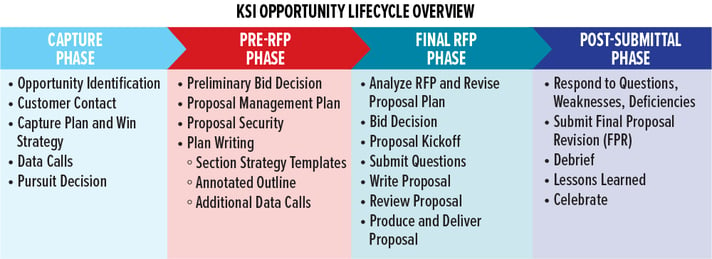 This is an abridged version of our KSI opportunity lifecycle, a more detailed overview is available in our KSI Advantage™ Capture & Proposal Guide.
This is an abridged version of our KSI opportunity lifecycle, a more detailed overview is available in our KSI Advantage™ Capture & Proposal Guide.
Conduct your research, develop a clear understanding of the customer, and focus on viable bids. Again, don’t get excited about dollar signs and chase every contract; you will spread your resources thin and misdirect valuable attention from bids that you have a chance of winning to those that are not viable.
Proposals are an extension of your company/brand and need to be viewed as a way to make a lasting impression on your clients.
People who go after every opportunity tend to rely heavily on reused, copy and pasted content to keep up with the fast pace with which RFPs are issued. What is your win ratio?
You will end up with a burned-out and demoralized team if you keep submitting proposals and win few or no awards. If you do not have the necessary resources to put together a credible bid, then don’t send one in. It is better to pass on an opportunity than to turn in a poorly written, non-responsive proposal. You will leave a bad impression of your company and worsen your chances of being successful in the future.
What gets in the way of good decision-making?
Lots of people know the principles of bid/no-bid decisions and yet find themselves unable to say no, stuck in the habit of chasing lost cause opportunities. There are certain facets of human cognition and behavior that lead us to make poor decisions against our better judgement. It’s vital to be aware of these tendencies and combat them in your bid/no-bid meetings.
Sunk Cost Fallacy: Many people continue to invest in something solely because they invested in it in the past. In business development, this can include continuing to pursue a bid because of the previous expenditures invested in going after it. Past investments are not a good justification for future investment choices. It can be better to cut your losses than continue investing in a lost cause.
Cognitive Dissonance: Continuing to pursue a bid that you are clearly not positioned to win will unduly stress your team and cost the company money it cannot recover. Leave ego out of decision-making and recognize when conditions are untenable.
CONCLUSION
By starting from a point of “no,” you shift the focus onto building a case for why you can justify bidding instead of why you cannot. This perspective emphasizes a sober assessment of your positioning and pre-proposal capture activities and creates a culture that weaves bid re-assessments at regular intervals in your proposal development process. Making data-backed bid/no-bid decisions will allow you to focus your efforts on revenue-driving bids that you can actually win.
If your team needs help implementing a data-driven, qualify-first capture process, visit our Capture Services for more information.
This article was originally published on June 17, 2020, and was updated on February 1, 2024.



